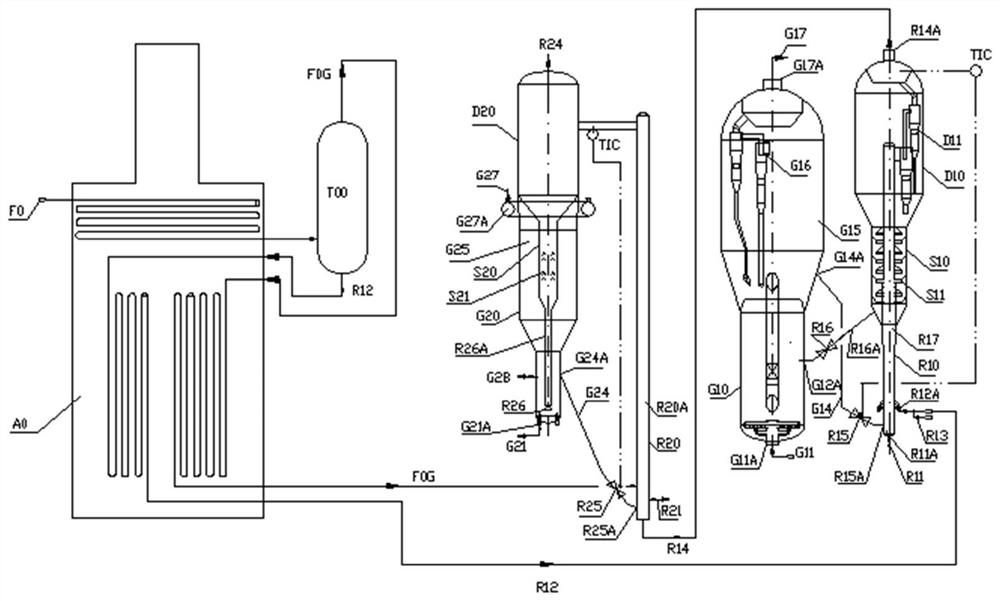Method and device for preparing ethylene and propylene through catalytic conversion of crude oil
A catalytic conversion and crude oil technology, which is applied in the direction of hydrocarbon cracking to hydrocarbon, only multi-stage series refining and cracking process treatment, hydrocarbon oil treatment, etc., can solve high reaction temperature, reduce catalytic cracking reaction effect, and regeneration heat release cannot provide Heat and other issues
- Summary
- Abstract
- Description
- Claims
- Application Information
AI Technical Summary
Problems solved by technology
Method used
Image
Examples
Embodiment approach 1
[0085] The method for preparing ethylene and propylene by catalytic conversion of crude oil in this embodiment adopts figure 1 In the device shown, a first reaction regeneration system and a second reaction regeneration system are provided downstream of the crude oil heating furnace or heat exchanger A0 and crude oil separation tower or flash distillation tower T00; the crude oil F0 is used as the raw material, and the crude oil F0 after desalination and dehydration is used After the crude oil heating furnace or heat exchanger A0 is preheated, the crude oil separation tower or flash distillation tower T00 is used to separate into two components by boiling point, namely the heavy crude oil R12 and the light crude oil F0G. The heavy crude oil R12 is Catalytic conversion ethylene production unit carries out catalytic cracking to produce ethylene, and the light component of crude oil F0G is sent out of the unit; in specific implementation, crude oil heavy component R12 is a mixture c...
Embodiment 1
[0097] A factory adopts figure 1 The shown catalytic conversion of crude oil to ethylene plant to process crude oil to produce ethylene products;
[0098] The crude oil comes from an electric desalination unit, with properties: density 0.84, hydrogen content 13.0, K value 12.2, Ni content less than 3.0ppm, V content 0.3ppm; crude oil F0 temperature is 135℃;
[0099] The process parameters are as follows:
[0100] The crude oil after electric desalination and dehydration is pressurized to 1.3MPa, heated to 240℃ and then enters the flash distillation tower or preliminary distillation tower to separate the non-condensable gas and the naphtha component with the boiling point below 180℃; 15% of the crude oil Non-condensable gas and naphtha are sent out of the device, and other components, namely heavy components, are heated to 250°C by the heat exchanger, atomized with steam, and enter the first reactor for reaction;
[0101] The first catalyst: Lanzhou Petrochemical's heavy oil high-effic...
Embodiment approach 2
[0111] The method for preparing ethylene and propylene by catalytic conversion of crude oil in this embodiment adopts figure 2 In the device shown, a first reaction regeneration system and a second reaction regeneration system are provided downstream of the crude oil heating furnace or heat exchanger A0 and crude oil separation tower or flash distillation tower T00; the crude oil F0 is used as the raw material, and the crude oil F0 after desalination and dehydration is used Separate into crude oil heavy component R12 and crude oil light component F0G. Both crude oil heavy component R12 and crude oil light component F0G enter the catalytic conversion ethylene unit for catalytic cracking to produce ethylene; the crude oil light component FOG is heated to 350°C to 560°C, and the crude oil The heavy component is heated to 250 to 360°C and then enters the reactor;
[0112] A crude oil light component inlet is provided at the lower part of the second reactor R20, and the crude oil ligh...
PUM
| Property | Measurement | Unit |
|---|---|---|
| boiling point | aaaaa | aaaaa |
| boiling point | aaaaa | aaaaa |
Abstract
Description
Claims
Application Information
 Login to View More
Login to View More - R&D
- Intellectual Property
- Life Sciences
- Materials
- Tech Scout
- Unparalleled Data Quality
- Higher Quality Content
- 60% Fewer Hallucinations
Browse by: Latest US Patents, China's latest patents, Technical Efficacy Thesaurus, Application Domain, Technology Topic, Popular Technical Reports.
© 2025 PatSnap. All rights reserved.Legal|Privacy policy|Modern Slavery Act Transparency Statement|Sitemap|About US| Contact US: help@patsnap.com



